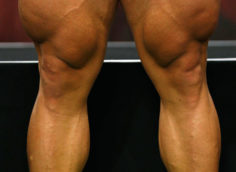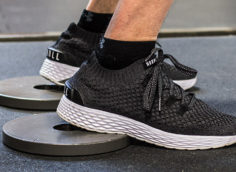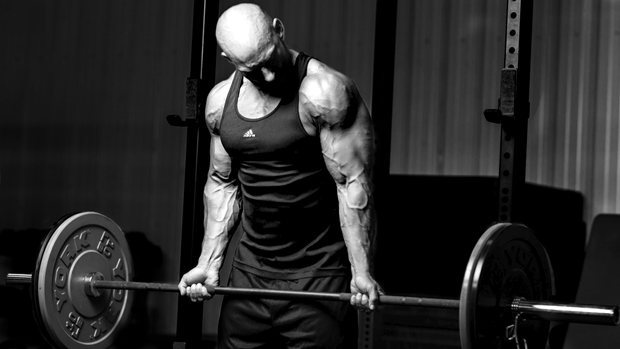Building a Better Boomerang
In Part I and Part II of this series, we explained how some creative thinking and efficient programming can kill a flock of birds like a boomerang. Instead of using one dimensional thinking and throwing rocks by doing cyclical modes of cardio, why not try to cover as many needs as possible in a short period of time with a circuit of exercises?
Modules are universal training blocks that can be used to group together complementary exercises to fit into a common theme. Modules aren't just for organizing circuits; they're efficient ways to pattern common training programs into small units that can be adjusted and placed to fit the needs of workouts. Be it an individual session, training phase, or team program, modules are fantastic tools.
One very effective way to organize a program is to use modular blocks of training, and connect them into sequences so you can make training more efficient. An individual module can be used interchangeably for a variety of purposes, depending on when you use it and what your goals are. The main benefit of using modules is that training becomes very organized, therefore maximizing your results with what you have for time and facilities.
Currently, we're using a variety of modules to design training programs that are customized for our clients, without paying the price of taking enormous amounts of time to write down every detail. While some critics may argue that modules are flirting with being cookie-cutter programs, when you see how we manipulate the units into training sessions, you'll realize that the possibilities are endless for your own workouts and you can adjust them to fit your own needs.
Training Module Construction
The first step in constructing training modules is to review what your needs are. For example, someone who's doing mostly cosmetic, hypertrophy-style workouts will have slightly different needs than an athlete preparing for a maximal strength phase. Still, most everyone will have similar postural issues, warm-up needs, cardiovascular requirements, and strength training protocols to address.
What we've found is that many coaches find what tends to work best, as many people are in the same boat with constraints such as time, staffing, facility size and equipment. Modules are "open source" mini-programs that can be edited slightly to fit your individual needs.
The Spinal Animal Module
One progression we've found to be useful with many athletes is the Spinal Animal Module. Any training that involves a spinal requirement can benefit from this short program, and the sequence below doesn't need special equipment or expertise in anatomy.
Carl took Mike's exercise menu for spinal health and comprised a sequential order he felt worked in harmony with his athletes. Many of our clients can use the module because it's general enough to fit their needs, but specific enough to target necessary details involved with heavy weight training.
This routine involves five movement postures that help with maintaining spinal health and teach coordinative programs to the nervous system. While it may appear simple at first glance, this module can be modified or morphed into dozens of different combinations.
Again, if you look at the photos below in order, you can see how this sequence of movements flows together nicely, and that's no accident. One very important factor with modules is that they're created organically, not just made up on the spot with some strength guru meditating on an Olympic lifting platform. Over time, elements are assembled together and are constantly evolving by eliminating the superfluous, and keeping what's effective.
Most of the time, trial and error will develop training modules, but every so often a genetic leap occurs with some creative coaching. After several stages of evolution, workouts become better designed and the universal parts of a workout can be shared with other trainees and coaches.
The purpose of the module below is threefold. First, it's a quick check to see if any lingering issues are still harbored in the spine and if you're ready to lift heavy. Second, it's a great way to open the spine by mobilizing the vertebrae through natural ranges of flexion, extension and rotation. Third, the exercise sequence itself teaches and cues athletes how to get into proper positions for squatting, deadlifting or any exercise requiring a specific spinal position.
Here's the Spinal Animal with photos and coaching cues.
Cheetah Stretch Pose: This is a great way to start releasing the calves and Achilles tendon, while adding a shoulder stabilization demand. Options include shifting the weight back and forth from right side to left side for more targeted stretching of the lower leg and foot.
 |
The Dog Pose: The primary function here is to get complete lordosis of the spine in order to prepare for heavy squats, deadlifts or any lower extremity exercise that loads the spine. Learning this position teaches the trainee to cue his or her spine before hitting the heavy weight.
 |
The Cat Pose: This is the foil to the dog pose. It can be used to help alternate between flexion and extension over and over to release the restrictions of the back and abdominal wall.
 |
The Cobra Pose: This movement challenges the extension quality of the lumbar spine. Just a few reps can help the mobility of the lower back, while monitoring for any abnormal alignments of the vertebrae. We've found that this pose is a great stretch for the abdominal wall after a solid core workout. As your range of motion increases, you should be careful not to apply too much pressure by trying to extend too far back or too rapidly.
 |
The Prone Scorpion: This exercise (currently bastardized by many performance coaches to make their programs more marketable to clients) is very effective to improve rotational aspects of the spine and improving glute activation. Allowing the torso to twist right and left so the feet can contact the ground flat requires the trainee to drive the knee high to get full range of motion.
A good cue is pretending to squash an ant on the ground with your shin being as vertical as possible. Each foot contact to the ground is considered one rep, and most trainees need 10 to 20 reps with each leg to open up the paraspinals. As well, you should really focus on squeezing/activating the glute before movement!
 |
The next step is to see how many modules work together in an actual workout. Since we believe that cardiovascular training can be done first if adjusted properly, we'll give a sample workout of an athlete doing an off-season phase for football when he has only a little over an hour to train.
We'll use only the exercises we shared in Part II of this series as well as a few movements from the Neanderthal No More Series to prove that you can do a lot without expanding your exercise selection. We vary the routine and biomechanics of the movements slightly to fit the specific needs of the day, and comment on what we adjusted as well as why.
Off Season Football
Lower Extremity Strength and Power Day
P.H.I.R.E. Routine – When you're lifting for strength and power, injuries are obviously a risk. It's best to be patient and not try to get into intense lifting until you're thoroughly warmed-up. All of the joints, muscle, connective tissue and nerves must be "test driven" for at least 20 minutes before you touch the heavy weights. This warm-up takes anywhere from 20-30 minutes to complete.
Module 1: Core Training, Warm-up – Dead Bug and Iron Cross Series (4 minutes, 3 rounds)
Alternating 1 x 10 reps Dead Bugs with 5 second hold per side
1 x 30 for the Iron Cross movement
Commentary: We like using the lighter core exercises first to teach technique and save the dynamic flexibility for later when the tissues are supple from heat.
Module 2: Core and Cardio – Metapump Pull Pike Press (20 minutes, 10 rounds)
Stability Ball Pike followed directly into a push-up, 1 x 10 reps
45 seconds of Bent Over Butterfly Pulls with 15 seconds rest
Commentary: Many times a leg day will be after a push or upper body day so it's imperative to get localized blood flow in the chest and arms to facilitate recovery. By being in a push-up position and alternating between isometric and isotonic contractions, the chest and arms will be targeted directly.
Also, directly and indirectly the core is again challenged with push-ups and pikes, making this combination very time effective. Lastly, the Bent Over Butterfly Pulls are great because tubing rarely causes any DOMS. This set is the primary part of the cardio and is great for those with little space or with small budgets.
Module 3: Prehabilitation, Flexibility, Diagnostic – Spinal Animal Routine (4 minutes, 3 rounds)
No need to review this one again; just remember that it's not a filler designed to bore you with more training.
Module 4: Post-workout, Prehabilitation – Poor Man's Shoulder Horn (4 minutes)
3 x 8 reps
 |
Commentary: It's a good idea to do rotator cuff work after training so that they're not fatigued before any lifting. Although it was a lower extremity day, the upper body was used for the deadlifts so we didn't want to do any shoulder prehab before.
Remember, any core exercise could've been placed into the Module 1 zone, but the theme had to be core. What gives modules a clear benefit is that you can slide in various workouts of similar themes and durations by adjusting other workouts you like into modules that fit. Using this approach won't "supercharge" your workouts, but it'll allow for more organized approaches to training. By improving the organization of your program design with efficient training blocks, you can change and enhance training at a blistering speed.
Create Your Own!
Now that you've seen a couple of examples of how to design a program, it's time to give you the necessary tools to create your own circuit. Below are modules that we often pull our exercises from, along with several examples of exercises that fall within the module.
Please keep in mind that these circuits are only limited by your own imagination! The exercises and modules listed below are only a starting point. Feel free to plug in your own exercises and modules as needed; just focus on staying within the parameters that we've given in previous articles.
Module: Upper Body Prehab, Rotator Cuff
Exercises: Shoulder Horn, Poor Man's Shoulder Horn, 90 degree external rotation, Side Lying External Rotation
Module: Upper Body Prehab, Scapular Stabilizers
Exercises: Scapular Wall Slides, Ball I, Y, T, W Circuit, Push-up Plus
Module: Lower Body Prehab, Glute Activation
Exercises: Scorpions, Bridges, Glute Walks, Lawnmowers
Module: Lower Body Prehab, VMO prehab
Exercises: Deep Squats, Lunges, Bulgarian Squats, 6" Box Lunge, Step-ups
Module: Lower Body Recovery
Exercises: Squats, Lunges, Deadlifts, Step-ups, Glute-Ham Raise
Module: Upper Body Recovery
Exercises: Bench Press, Lat Pulldowns, Chest Supported Rows, Triceps Pushdown
Module: Dynamic Flex
Exercises: Toy Soldiers, Walking Spiderman, Inchworms, Walking Lateral Lunge, Squat-to-Stand
Module: Core (could also be divided further into different movements such as stability, flexion, rotation, etc.)
Exercises: Crunches and variations, Hanging Leg Raise, Dead Bugs, Windmills, Saxon Side Bends
Your Turn!
Hopefully the above list has gotten your brain going a little bit. Please keep in mind it's not our goal to give you a cookie-cutter circuit! The goal here is to give you the tools necessary to build your own boomerang. What we'd really like to see is how creative some of you can be, so feel free to post your own circuits in the "comments" section below and let us know how it's working for you.
The longer you train, the more you realize there's very little room for black-and-white thinking when it comes to training; rather, proper application and performance are critical to getting the most out of your workouts. Give the Superior Circuit PHIRE program a try and we're sure that you'll be very pleased with the improvements in your physique and the increases in training performance!



